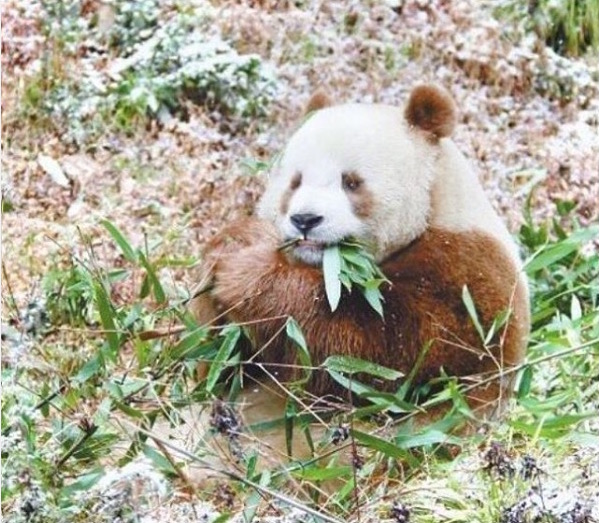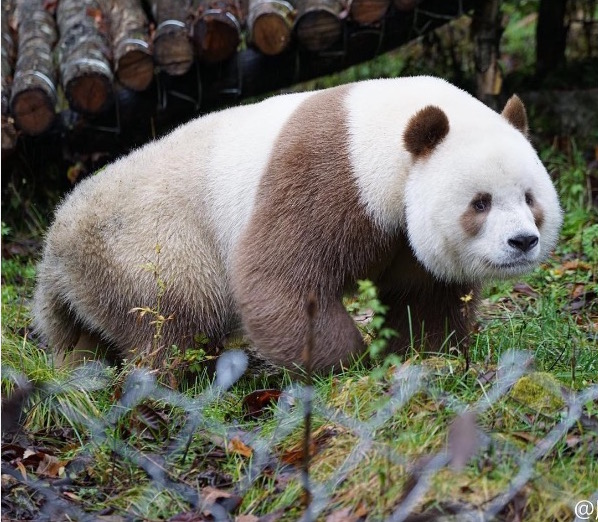You might not be an expert on wildlife, but you don't need to be to know exactly what a panda looks like. Their distinctive black-and-white pattern makes them stand out in the animal world — that, and their chubby, bumbling cuteness.
But while the classic idea of a panda — the one we're all imagining right now — is bright white and jet black, that's not actually always the case. Sometimes, on very rare occasions, a panda is born with brown, softer caramel-colored fur in place of the black.
Pandas give birth rarely enough as it is, due to the females ovulating only once a year, and so anytime a baby is born, it's a cause for celebration — especially since there are only 1,864 in the wild. Plus there are few things more adorable than a baby panda.
And giving birth to a brown panda is even more rare. Since 1985, there have only been five recorded instances of brown pandas, and right now, there is only believed to be one in the whole world.
That brown panda is Qizai, who currently lives at the Foping Panda Valley in China's Shaanxi Province. He's about seven years old, and it's believed his coat comes from a genetic trait specific to pandas from the Qinling Mountains. So far, the only brown pandas ever spotted have been spotted in these mountains.
Qizai's caretaker, He Xin, says that Qizai is "gentle, funny, and adorable," but that he's also a bit slower than the other pandas.
Check out Qizai below. You've never seen a panda quite like this!
[H/T: Daily Mail, 2]

Meet Qizai, who has the honor of being the only known brown panda in the entire world.
Instead of black fur on his limbs, ears, and under his eyes, Qizai has a soft brown fur, which is extremely rare.
Qizai lives in the Foping Panda Valley, a panda center. He was brought there after being found, alone and malnourished, as a two-month-old cub. He was nursed back to health, and today he's doing great.

It's thought that this brown fur comes from a genetic mutation specific to the small, isolated group of pandas that come from the Qinling Mountains in the Shaanxi Province.
But no one's entirely sure. Qizai's mother had black and white fur, so it may be a recessive trait.

And it also seems that being a little different in the panda community has some strange parallels to being a little different in the human community.
His handlers report that for a while, Qizai was "bullied" by his fellow pandas.

According to handler He Xin, Qizai is a bit slower than the other pandas, which led to the others stealing his food, as he eats more slowly, too.
As an adult, Qizai now has his own enclosure, so he doesn't have to worry about anyone stealing his bamboo anymore.

"When I called out their names, the other black-and-white pandas would react and come to me quickly," he says. "But for Qizai, it usually takes some time for him to realize that."
"He's slower than the other animals, but he is also cuter," he adds.

Now that he's seven, the center will start looking to match him up with a female.
Not only do they hope for Qizai to become a dad and continue to grow the panda population, but they're also interested in seeing how his unusual coloring is (or isn't) passed down to offspring.

For now, though, Qizai is enjoying simply being a panda, eating five times a day, and lounging in the sun.
Other than the color of his fur, Qizai is an average, if slow-moving, panda. He's average-sized at a little over 220 pounds, and eats the panda average of 44 pounds of food a day.

And his brown fur continues to fascinate people.
Depending on the region they come from, there is a slight variation in the color of pandas' fur. Pandas from Shaanxi have a slightly lighter fur than the ones from Sichuan, but Qizai's fur is lighter than most people have ever seen.

Pandas have been making a comeback after being on the endangered species list for a long time, although they're still classified as "vulnerable."
Check out Qizai in action in the video below, and please SHARE if you think every panda deserves our love and respect!




